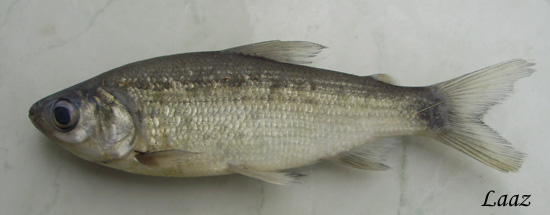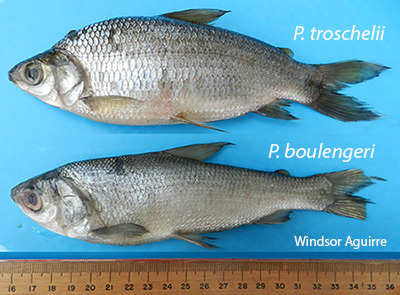Curimatidae - Pseudocurimata boulengeri (Eigenmann, 1907) |
 |
| SOURCE FOR OCCURRENCE IN ECUADOR: This species is very common in the Guayas River drainage. There are many references for its occurrence in the area (e.g., Eigenmann, 1922; Ovchynnyk, 1971; Barnhill et al., 1974; Gery, 1977; Glodek, 1978; Vari, 1989; Barriga, 1991; Florencio, 1993; Laaz et al., 2009; Prado, 2009; Laaz & Torres, 2010). |
| ORIGINAL DESCRIPTION: Eigenmann, C.H., and F. Ogle. 1907. An annotated list of characin fishes in the United States National Museum and the Museum of Indiana University, with descriptions of new species. Proceedings of the United States National Museum 33 (no. 1556):1-36. |
| TYPE SPECIMENS: |
| TAXONOMIC STATUS: Valid (Eschmeyer and Fricke, 2011). |
| RANGE ECUADOR: Guayas River drainage. |
| RANGE OUTSIDE OF ECUADOR: None. |
| COLLECTIONS IN ECUADOR: |
| MAXIMUM SIZE: 29.0 cm (Barnhill et al., 1974). |
| DISTINGUISHING FEATURES: Pseudocurimata boulengeri is distinguished from P. lineopunctata and P. patiae by the absence of small, discrete, dark spots aligned in longitudinal rows on the lateral and dorsolateral surfaces of the body, which the latter two species possess. Pseudocurimata boulengeri has 36 or 37 vertebrae while P. lineopunctata and P. patiae have 31 to 33 vertebrae, and P. boehlkei has 33 or 34 vertebrae. Pseudocurimata boulengeri lacks the discrete spot at the base of the middle caudal-fin rays characteristic of P. peruana, and has 50 to 57 scales along the lateral line to the hypural joint, compared to the 42 to 47 that typify P. troschelii, and the 39 to 42 of P. boehlkei (Vari, 1989). |
|
 |
Top: Specimen of Pseudocurimata troschelii. Bottom: Specimen of Pseudocurimata boulengeri. Note difference in body depth. Also not difference in scales along lateral line. Pseudocurimata boulengeri has a significantly higher number of scales than P. troschelii. Both specimens were collected in Daule-Peripa Reservoir, northern Guayas River drainage.
|
|
| ECOLOGY: Pseudocurimata boulengeri is known in Ecuador as the “dica”. It is a large, ecologically important herbivorous fish that feeds on detritus from the bottom of streams (Barnhill et al., 1974). |
| ECONOMIC IMPORTANCE: This is an important food fish for people in rural parts of western Ecuador (Prado, 2009). |
| CONSERVATION STATUS: NA, although the species is heavily exploited as a food species. |
| LINK TO FISHBASE PAGE: Click here for link |
| SPECIES PROFILE CREATED BY: Enrique Laaz |
| SPECIES PROFILE CONTRIBUTORS:Windsor Aguirre |
|
|
|
|
|
